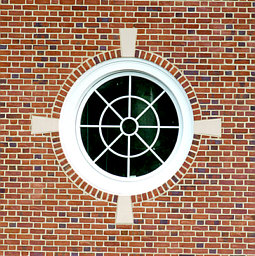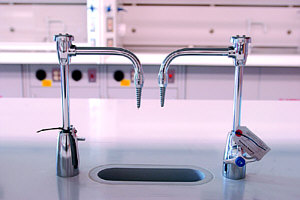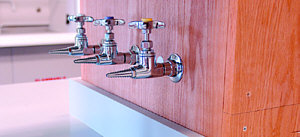Faculty, staff and students last week began moving
into the new $18 million, 50,000-square-foot chemistry
building on the Homewood campus. The building replaces the
antiquated 40-year-old Dunning Hall.
"The new building is going to be a significant
improvement in the facilities for research available to the
department," said Paul Dagdigian, chair of Chemistry. "I think it's a really
beautiful building on the outside, and the [interior]
architecture is fabulous. I'm confident that the design of
support systems will make it a very functional building as
well."
Gary Ostrander, vice dean for research and graduate
education in the Krieger School of Arts
and Sciences, said, "It's impossible to have a
first-rate university without a strong chemistry
department, and we really felt the need to support our
Chemistry Department's continued ability to excel and
expand."
In addition to the new building, which provides lab
and office spaces for eight faculty members (one of whom
the department anticipates hiring in the coming year) and
their students, the completed construction includes an
adjoining underground structure that will house the
multidepartmental Nuclear Magnetic Resonance Center for
Fundamental Studies of Biological Molecules.

Architectural detail
|
Craig Townsend, professor of chemistry and a member of
the committee that guided the center's creation, said,
"Large molecules are not static, and their behavior and
their interactions with each other and with small molecules
like inhibitors or drugs depend on the fact that they're
not static--they bend and stretch to interact. And NMR is a
technique which allows you to measure these things in
addition to getting structural information," he explained.
The NMR center soon will house a 600 megahertz
instrument and has room for installation of two or three
more such instruments in the future. In October, a
top-of-the-line 800 megahertz NMR unit will be delivered.
The high-field spectrometers will allow scientists to use
NMR to study more complicated systems with greater
sensitivity. The center is housed in a new underground
structure linked to lower levels of the new chemistry
building and of Mudd Hall, home of the Biology
Department.
Several faculty members characterized the creation of
the new building as a case of "all the stars coming into
alignment." When officials set out to renovate Dunning Hall
after the renovation of Johns Hopkins' other major
chemistry building, Remsen Hall, they determined that not
only would it be impossible to renovate Dunning in phases,
certain design characteristics of the building also would
make the renovation cost as much as a new building.
The possibility of a new building was easily matched
to a potential building site that had recently been
identified in the new master plan for the campus, completed
in 2000. This location was just a stone's throw away from
Dunning, between the Johns Hopkins Club and Macaulay Hall.
And the need for improved NMR facilities, which had been
growing in urgency in recent years, also could be met
through an expansion of the construction site.
Dagdigian and Ostrander praised the work of the
architect, the Ballenger Corporation of Philadelphia, and
the construction manager, Barton Mallow of Linthicum,
Md.
Dagdigian pointed out that integrating the new
building into its spot on campus required extensive
physical renovations around the building. "It's not like
just constructing a building out in the middle of an open
field," Dagdigian commented. "Construction of a large new
set of stairs, a loading dock, new parking to replace
spaces knocked out by the new building and new pedestrian
pathways were all required."
Dagdigian also noted that construction managers were
able to keep the building very close to schedule despite
significant weather-related delays like the blizzard of
February 2003 and extensive rains this spring and
summer.


Lab details.
|
The lab wing in the new building is constructed in a
modular style that lets researchers release and acquire lab
space as their research staffs shrink and grow over time. A
separate wing houses office space. Also included in the new
building are several open or shared instrument labs.
The new chemistry building was funded in part by a
$2.6 million grant from the state of Maryland. Johns
Hopkins also continues to seek private donations supporting
the construction of the new facility.
Acquisition of the 800 megahertz spectrometer was made
possible in large part through a grant from the National
Science Foundation and matching grants from the departments
of Biophysics in the School of Arts and Sciences on the
Homewood campus and Pharmacology and Molecular Sciences in
the School of Medicine on the East Baltimore campus.
Additional funding was supplied by the Krieger School of
Arts and Sciences. Townsend praised the interdepartmental
cooperation that made the new center possible and
emphasized that the center will be open and accessible to
researchers from all departments in the university.
"This really has been a pleasant and extremely
rewarding process because everyone has come together to
create a first-class research facility," Ostrander said.